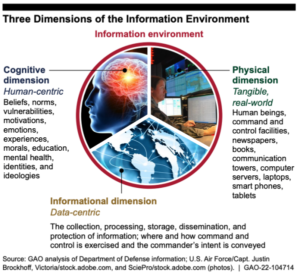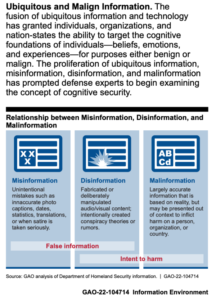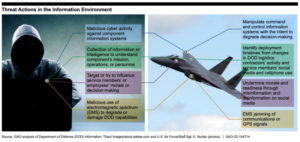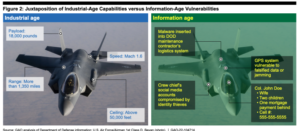I. Pentagon Report Admits Coginitive Security System to Control the Population (Feb. 2, 2023)
https://banned.video/watch?id=63dc4c96f246b125ed20d602
Alex Jones breaks down a Pentagon report detailing a cognitive security grid being used on an unsuspecting public in the modern mind control scheme now being openly admitted.
He details how, throughout the Western world, the military intelligence agencies worked with Big Tech to terrorize and scare the public into submission and into accepting the deadly Covid jabs and useless face masks.
Powdingfuk
2 hours ago
Shit! Why can’t we understand that this is the only planet with humans on it. There is no other planets like this. We have cars, clothes,fire, flight,tec, etc.. but we will go down as the dumbest creatures that ever walked the planet. With the geoenginering, vaccines, 5G, video & audio propaganda to devide the people on race, religion, sexual organization. We will destroy ourselves instead of all working together from every region of the planet. Thank you infowars for trying to wake humanity up. Im afraid its to late
0
Advoc8
3 hours ago
Military Industrial CONplex.
0
BIDENSUCKS
3 hours ago
Meta means dead in Hebrew. The Metaverse is a part of the cyberworld. So through this nanotechnology from the vaccine, have they’ve been captured.
II. GAO Report on Contested Information Environments: Actions Needed To Strengthen Education and Training For DOD Leaders
January 31, 2023 9:40 AM
The following is the Jan. 26, 2023, Government Accountability Office report, Contested Information Environment: Actions Needed to Strengthen Education and Training for DOD Leaders.
From the report
What GAO Found
Department of Defense (DOD) guidance for operating in a contested information environment continues to evolve as DOD works to develop and prepare leaders to make effective decisions. The information environment––that is, the aggregate of factors that affect how humans and automated systems derive meaning from, act upon, and are impacted by information—is at risk of adversaries from anywhere attacking and contesting it to undermine DOD operations. In 2017 DOD elevated “information” as a joint function, and in 2019 it identified Globally Integrated Operations in the Information Environment as a special area of emphasis for education. As adversaries increasingly aim to distort or compromise information available to leaders, the focus on leader decision-making approaches becomes more important to minimize negative effects on military readiness and the successful execution of military operations (see figure). DOD continues to take steps—such as establishing a doctrinal, operational, and technical framework—to improve its understanding of and effective operation in increasingly contested information environments.

As part of its efforts to prepare for contested information environments, DOD offers education and training for its leaders. However, DOD components are unclear about what information environment aspects to cover in such education and training because guidance does not specify what content to include. DOD officials also reported having limited resources for their education and training efforts and cited simulation, infrastructure, and personnel limitations as further impeding these efforts. Officials stated that these limitations hinder the creation of realistic environments in which leaders can practice decision-making skills. However, DOD has not assessed or comprehensively reviewed component assessments of resources. Until DOD develops guidance and assesses its resources, it will lack assurance that it will be able to educate and train leaders to prepare them to make decisions in a contested information environment.
Why GAO Did This Study
According to DOD, our competitors and adversaries are taking advantage of vulnerabilities in the information environment to advance their national objectives and offset the U.S.’s position as the preeminent warfighting force. DOD’s military operations in the information environment play a pivotal role in engaging our adversaries.House Report 117-118 included a provision for GAO to review DOD training that prepares leaders and service members to operate and make decisions in a contested information environment. In this report, GAO (1) describes DOD guidance that supports the department’s education and training efforts to prepare leaders to make decisions in a contested information environment and (2) assesses the extent to which DOD provides education and training designed to prepare leaders to make such decisions.GAO reviewed selected DOD strategies, policies, and course syllabi; analyzed information related to the conduct of military exercises; and interviewed officials with knowledge of the department’s education and training efforts.
What GAO Recommends
GAO recommends that DOD (1) develop guidance about what content to incorporate in its education and training related to decision-making in a contested information environment and (2) assess the resources necessary to meet related education and training needs. DOD generally concurred with GAO’s recommendations.
Download the document here.
III. DoD Adds “Cognitive Security” to Governmental Disinformation Campaign
By Wendi Strauch Mahoney – February 2, 2023

A 59-page report from the U.S. Government and Accountability Office (GAO) underpins much of the updated information policy and guidelines that are now present in all branches of the U.S. military. This report is the big “tell” about the direction of the DoD’s thought process about the “opportunities and threats to the DoD’s national security mission.” Familiar mis-,dis-, and mal-information terms like the “cognitive dimension” of the information environment as well as “cognitive security,” is discussed. The goal of the report is to help our DoD “protect the information environment.” GAO administered questionnaires to the leadership of 25 DoD organizations “asking about the information environment’s effect on their organizations.” The performance audit was conducted from January 2021 to September 2022.
UncoverDC has reported extensively on the government’s incursions into the domain of information and free speech. Cognitive infrastructure is now a common and consistent construct in the lexicon of agencies like CISA, the FBI, the DOJ, etc. While it is understandable for the DoD to want to protect our national security interests, trust in our government is at an all-time low. Many Americans feel they are no longer able to freely digest and disseminate information that agrees with their worldview. In many cases, as understood most recently because of the Twitter files and the seminal free speech case, Missouri v. Biden, Americans realize that much of the information on the internet is and has been highly controlled and non-conforming perspectives suppressed.

GAO Report on Information/https://www.gao.gov/assets/gao-22-104714.pdf
GAO Report: Cognitive Security
Featured prominently on the first page of the report is the now omnipresent mis-, dis-, and mal-information campaign. The GAO investigation found a “proliferation of ubiquitous [and malign] information, misinformation, disinformation, and malinformation” that has “prompted defense experts to begin examining the concept of cognitive security.” Thus is introduced a relatively new term into the government’s national defense lexicon— “cognitive security.” Cognitive security is a subset of “cognitive infrastructure.” This type of infrastructure has often been weaponized against Americans on social media platforms and in the media.
Cognitive resilience is another widely used term to describe a teachable process that helps “cultivate critical thinking and media literacy through education, as well as the development of tools that can provide real-time identification and defense for people and organizations encountering sophisticated influence efforts.”
GAO report/https://www.gao.gov/assets/gao-22-104714.pdf

On one hand, the threat to our national security of poorly vetted information is real in the now information-rich virtual environment. Foreign actors work daily to infiltrate and influence public opinion, so it would not be far-fetched to believe they have their sights trained on military operations. The GAO highlights a number of “cyberspace threats, information or intelligence collection threats, influence threats, and EMS threats that adversely affect DoD personnel and capabilities,” as featured in the graphic below:
GAO Report/https://www.gao.gov/assets/gao-22-104714.pdf

The GAO report references a number of concepts and technologies that are now making their way into public awareness, such as fifth-generation wireless technologies that are “engineered to greatly increase the speed and responsiveness of wireless networks.” Such technology is increasingly the building block of an “extended reality” and “The Internet of Things” (internet-capable devices like phones and wearable devices). These technologies, according to the report, can have “positive benefits or negative consequences for the DoD.” These tools have the potential to distribute information rapidly, which impacts the ability to do damage control should bad information be disseminated. As such, all military branches must be properly and uniformly trained in a relatively new “doctrine” that reflects the “fundamental nature of information in joint operations.”
Again, the threats are real and should not be underestimated. There is a stark difference between the “industrial age capabilities” of our military and the “information age vulnerabilities” our service members must now confront. No doubt, we are changing how we fight because of our information-rich world. As stated in the report with its accompanying graphic:
“These information-age activities allow adversaries to target our capabilities and adversely affect military business functions and missions in ways that offset the industrial-age advantages we have developed, as shown in figure 2.
As a result of these activities, DoD must continue to find ways to protect information, systems, and minds through disparate security fields, such as information security, operations security, cybersecurity, physical security, and cognitive security.”
Page 2 GAO Report/https://www.gao.gov/assets/gao-22-104714.pdf

The Risks of Coordinated and Controlled Information
We are now a much more skeptical nation with regard to our First Amendment rights, and rightfully so. As previously stated, our government has waded into the territory of tyranny in the last few years, waging war with what most Americans hold dear; their freedom to think and speak freely, whether in person or on the internet.
Concerning our national security interests, the discussion is necessarily contextual. Had our government not pushed the boundaries of what has now come to be known as allowed speech, we might not be concerned over DoD policies that seek to explore how “adversaries can target the cognitive foundations of individuals.” It is one thing to be guarded against the informational threats of foreign actors, but it is quite another to target and/or label American citizens or maybe even our own service members with the same level of perceived threat.
Just two years ago, our own DoD, military service branches, and CDC worked together with big tech to #killthevirus in service of the promotional uptake of the COVID-19 mRNA shots and other government-sponsored research and treatments. Multiple town halls run by the U.S. Army led by Dr. Steven Cersovsky, Senior Advisor, MEDCOM and deputy director of the Army Public Health Center, pushed the vaccines, masking, and social distancing policies. In tandem, every branch of the military distributed controlled social media messaging on the subject. They also pushed shots for children. To wit, uniform and controlled messaging put out by the DOD is not always as neutral as they might have you believe. More importantly, millions listened and complied, in some cases, to their detriment.
